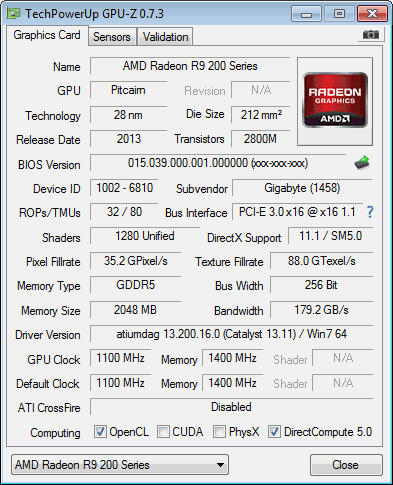Gigabyte Radeon R9 270X OC Review
Published by Christian Ney on 01.11.13Page:
Technical Data / Specifications
Gigabyte ships its Radeon R9 270X OC card with the core clocked at 1'100 MHz and the memory at 1'400 MHz (5'600 effective). Compared to the R9 270X reference clocks the Gigabyte OC has a shy factory overclocking with 50 MHz on the core. Unfortunately no factory overclocking was made on the memory.During our testing we didn't see the PowerTune Boost in action with the Gigabyte OC, the card was always running at full speed of 1'100 MHz under load even under Furmark.

| MSI HAWK | ASUS DirectCU II Top |
Gigabyte OC | Radeon R9 270X | |
| Chip | Pitcairn XTL Curacao XT |
Pitcairn XTL Curacao XT |
Pitcairn XTL Curacao XT |
Pitcairn XTL Curacao XT |
| Process | 28 nm | 28 nm | 28 nm | 28 nm |
| Transistors | 2.80 billion | 2.80 billion | 2.80 billion | 2.80 billion |
| GPU clock | 1'150 MHz | 1'120 MHz | 1'100 MHz | 1'050 MHz |
| Memory GDDR5 | 2'048 MB | 2'048 MB | 2'048 MB | 2'048 MB |
| Memory clock | 1'400 (5'600) MHz | 1'400 (5'600) MHz | 1'400 (5'600) MHz | 1'400 (5'600) MHz |
| Memory interface | 256 Bit | 256 Bit | 256 Bit | 256 Bit |
| Memory bandwidth | 179.2 GB/s | 179.2 GB/s | 179.2 GB/s | 179.2 GB/s |
| Shader Cores | 1'280 | 1'280 | 1'280 | 1'280 |
| TMUs | 80 | 80 | 80 | 80 |
| ROPs | 32 | 32 | 32 | 32 |
| TDP | 161 Watt | xxx Watt | xxx Watt | 180 Watt |
| PCB Type | Custom Design | Custom Design | Custom Design | Reference Design |
| Lenght (PCB - Total) | 25.4 - 26.1 cm | 24.3 - 27.3 cm | 23.8 - 28.5 cm | xx.x - xx.x cm |
| Height (PCB - Total) | 12.1 - 13.0 cm | 11.2 - 13.2 cm | 11.0 - 12.0 cm | 11.0 - 11.0 cm |
| Slots | 2 | 2 | 2 | 2 |
| Cooler | Twin Frozr IV Advanced | DirectCU II | WindForce 3X | AMD Reference |
| Launch Price | $XXX | $XXX | $XXX | $199 |
To cool its Radeon R9 270X OC, Gigabyte makes use of their very own WindForce 3X cooler. However it is not the WindForce 3X we are used to see, this one is completely different despite the same name. In this case you get only two eight millimetres copper heatpipes (non nickel plated), there are no six millimetres. The heatpipes are not in direct contact with the core, there is an extra copper plate in-between. Soldered to the heatpipes you find the fin stacks which are being fed with fresh air via three 80mm fans. They are manufactured by Everflow, carry the model number T128010SU and have been inclined in order to blow the air away better at the top of the card. manufactured by Everflow. Overall the cooler is well made and finished, there is only the area around the copper base that didn't get enough attention leading to what we call an industrial look. The copper base has been well lapped but doesn't have a perfect mirror finish. The thermal paste used is of good quality, soft and hasn't been uselessly spread in large quantity all around the chip.
Around the base you find an aluminium part which is used to fix the cooler to the PCB and also to cool all memory chips thanks to thermal pads. The MOSFETs are also actively cooled but with a separate little aluminium heatsink, right below a fan.
At closer look at the custom PCB shows that Gigabyte equipped its card with a so called 6+1+1+1 phase power design where the GPU gets six phases and the memory, PLL (VDDCI) and PCIe one.
Checking the voltage regulation chip we find a digital dual output 6+2 phase PWM controller IR3567A from International Rectifier for the GPU and memory voltage regulation. There are also two uP1542S from uPI Semiconductor ont the PCB, the one closer to the end of the card takes care of PLL (VDDCI) while the one close to the PCIe connector takes care of the PCIe.
The memory chips used are made by Elpida and carry the model number W2032BBBG-6A-F. They are specified to run at 1'500 MHz (6'000 MHz effective).
| Navigate through the articles | |
 MSI Radeon R9 270X HAWK Review
MSI Radeon R9 270X HAWK Review |
ASUS Radeon R9 270 DirectCU II OC Review
 |
|
|










